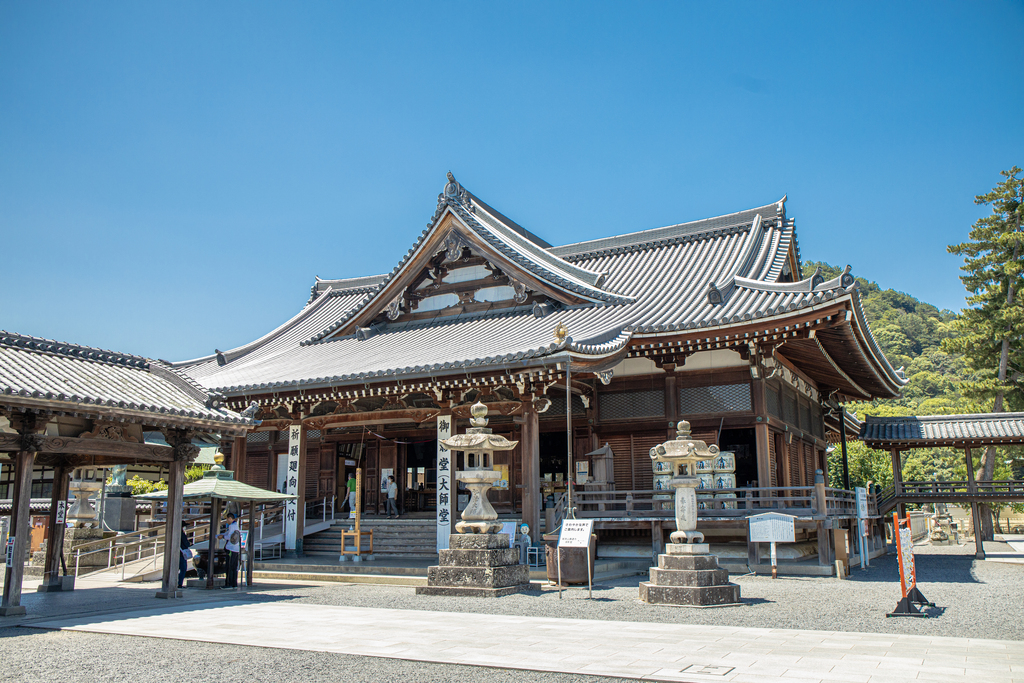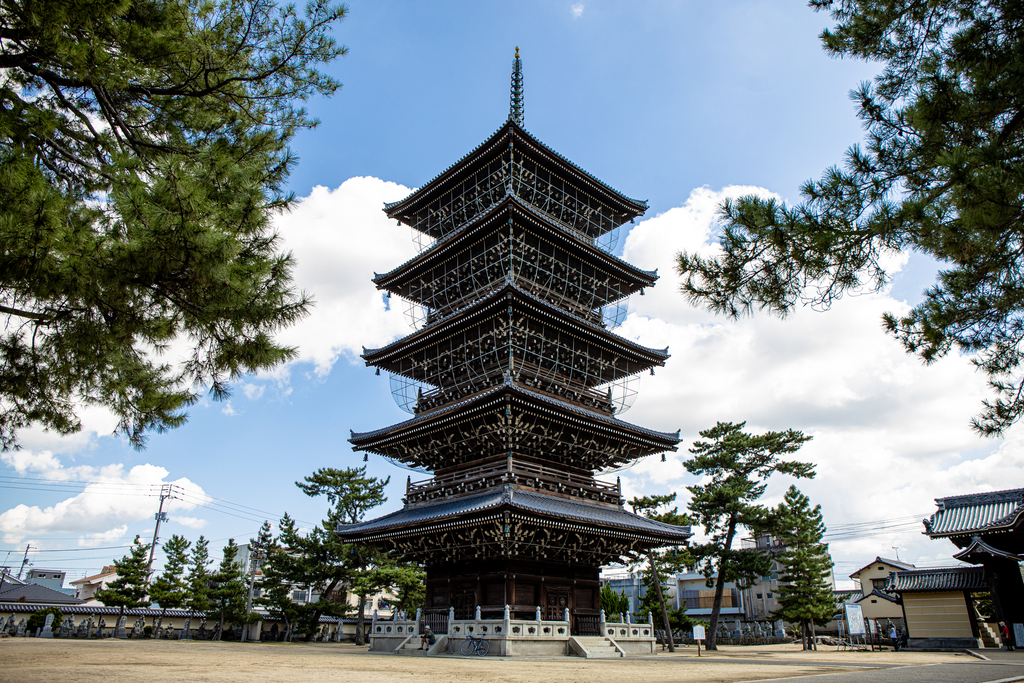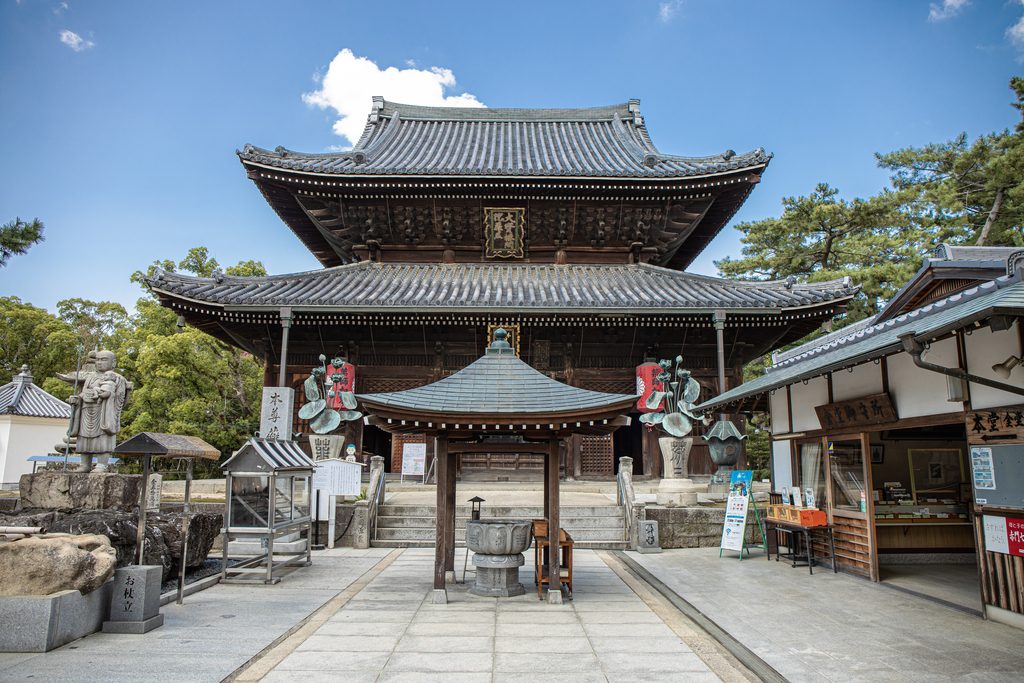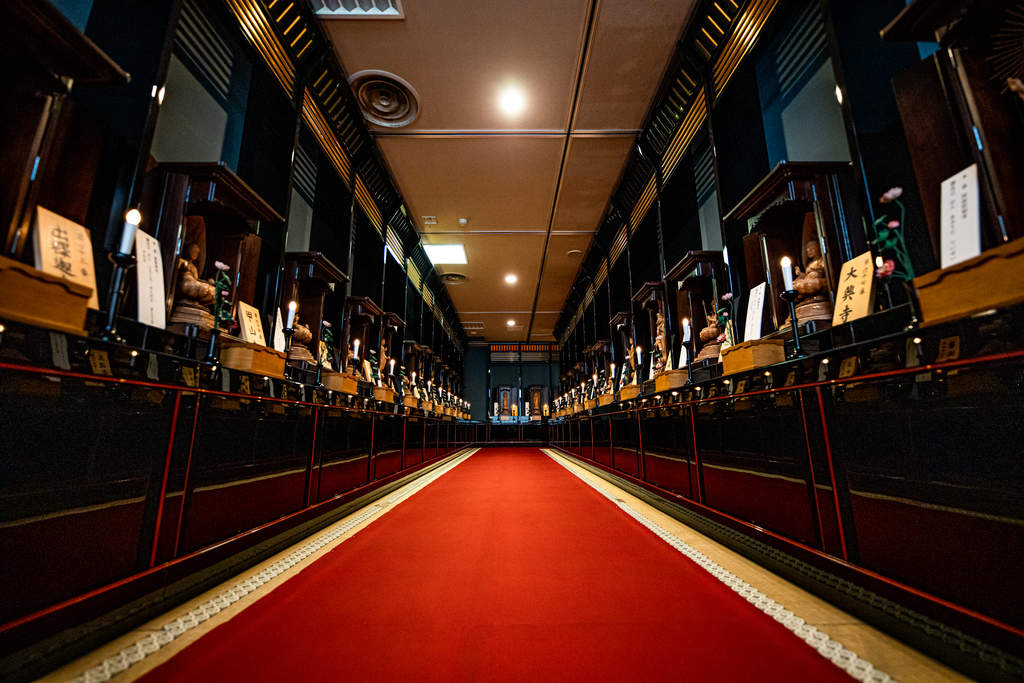 Photo: Shin-ichiro Hidaka
Photo: Shin-ichiro Hidaka
IslandsZentsuji Temple
Mieido Hall
 Photo: Shin-ichiro Hidaka
Photo: Shin-ichiro Hidaka
Mieido Hall
 Photo: Shin-ichiro Hidaka
Photo: Shin-ichiro Hidaka
Zentsuji Temple:
Five-Story Pagoda
The East Asian pagoda originated in the Indian stupa, which in its earliest form was a repository for sacred relics of the Buddha. Pagodas have been built in Japan since the arrival of Buddhism to the archipelago in the sixth century, and they remain a common sight at temples throughout the country. Zentsuji Temple has had a five-storied pagoda for centuries, though the wooden tower has been destroyed repeatedly by natural disasters and war. The current structure, located across from the Golden Hall at To-in (the eastern part of Zentsuji), is the fourth pagoda built on the site. It was built one story at a time over a period of 60 years due to funding difficulties; the temple could only afford to construct one floor every few years.
Finally completed in 1902, the pagoda is relatively earthquake-resistant due to its design, the main feature of which is a central pillar that is suspended from the ceiling rather than being anchored firmly in the ground. This structural design allows the pagoda to sway during an earthquake, reducing the potential damage caused by shaking. During the Golden Week holidays from late April to early May, visitors can enter the pagoda and climb a steep set of stairs to the second floor. At other times of the year, the structure’s closed gates are guarded from above by a mischievous-looking statue of jaki, a Buddhist guardian deity.
 Photo: Shin-ichiro Hidaka
Photo: Shin-ichiro Hidaka
Zentsuji Temple:
Sunafumi Dojo
The Shikoku Pilgrimage is a 1,200-kilometer journey to 88 temples across four prefectures and can take several months to complete on foot. Walking the pilgrimage, which is itself a religious practice, may not be possible for many, particularly those with mobility issues and other physical ailments. Fortunately, believers unable to walk the entire length of the route can pray at all 88 temples in one place at Sunafumi Dojo, a low-lit room in the Henjokaku building on the western side of the Zentsuji temple complex. Opened in 2006 to mark the 1,200th anniversary of Zentsuji’s founding, Sunafumi Dojo houses 88 wooden statues that represent the deities of the temples along the pilgrimage route. The figures were all carved by the Kyoto-based sculptor Matsumoto Myokei and differ slightly from each other, be it in posture, facial expression, or accessory items. Underneath the red carpet in front of each statue is a bag of sand from the temple enshrining the deity depicted. This sand represents the sacred ground of the temple and allows the pilgrim who steps on it to receive the same blessings as a visitor to the actual sanctuary. Sunafumi Dojo is a solemn place of prayer, but it is also a remarkably beautiful space that is well worth the detour for anyone visiting Zentsuji.
 Photo: Shin-ichiro Hidaka
Photo: Shin-ichiro Hidaka
Zentsuji Temple:
Mieido Hall and Kaidan Meguri
The Mieido Hall stands at the center of Sai-in, the western part of Zentsuji Temple. The hall is located on the site of the ancestral home of the Saeki family, birthplace in 774 of Kukai, the founder of Zentsuji and one of the most influential Buddhist priests in Japanese history. Sai-in was originally established during the Kamakura period (1185–1333) to honor Kukai and allow followers of the Shingon school of Buddhism, which Kukai founded, to pray at the place of his birth. The current Mieido Hall is a relatively recent structure, having been built in 1831 around a small inner sanctum (okuden), which is said to be located on the exact site of the chamber in which Kukai let out his first cry. The okuden is not open to the public, but visitors do have the opportunity to pass directly underneath it. This is done by braving the kaidan meguri, a pitch-black corridor that snakes below Mieido Hall. Entering the complete darkness of the kaidan meguri, visitors are asked to orient themselves by keeping their left hand on the left wall and proceed carefully. The utter lack of light makes for a meditative experience, which is well worth the ¥500 entrance fee. Kaidan meguri tickets include access to the Zentsuji treasure hall, where statues of Buddhist deities and other precious possessions are displayed.
Zentsuji is a temple of the Shingon school of Buddhism. It traces its history back to the year 807, when Kukai (774–835), the founder of the Shingon school and the son of a local aristocrat, restored his family’s ancestral temple and renamed it Zentsuji. An expansive complex, Zentsuji now consists of two adjacent sanctuaries: To-in or the Eastern Precinct, which Kukai founded, and Sai-in, the Western Precinct, which stands on the site of Kukai’s birthplace and was a separate temple until the late nineteenth century.
The Kondo or Golden Hall at To-in is Zentsuji’s main hall and houses a wooden statue of Yakushi (the Buddha of medicine and healing), the principal deity of the temple. Worship of the Yakushi Buddha has long been prevalent in Japan, both in Shikoku and elsewhere, because this Buddha is believed to help relieve suffering in this life rather than in the next. The current Golden Hall and its statue date back to the years 1699 and 1700 respectively; the originals were lost in a fire in 1558. Other noteworthy buildings at To-in include a five-story pagoda assembled story by story over a period of 60 years, and the temple’s main South Gate, a monumental structure erected to commemorate Japan’s victory in the Russo-Japanese War of 1904–1905. Nearby stand two majestic camphor trees, which are more than a thousand years old and are said to have towered over the temple grounds since the days of Kukai.
The grounds of Sai-in are somewhat less spacious than those of its neighbor but are revered by pilgrims who come to pay their respects at the Mieido Hall. Built on the site where Kukai was born, this ornate building enshrines the grand master of the Shingon school as a deity.
Important cultural property
20-minute walk from JR Zentsuji Station
(Main Hall) 7:00 a.m. to 5:00 p.m.
Free (Admission to the treasure hall is 500 yen for high school students and older, 300 yen for elementary and junior high school students.)